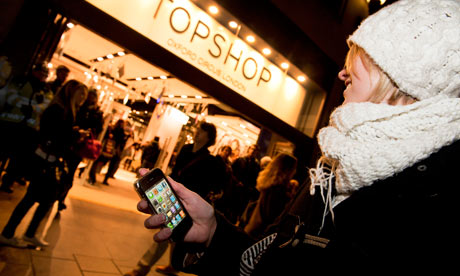Phone companies on the lookout for trends in the millions of texts, calls and internet searches made every hour have identified hotspots around store changing rooms as shoppers photograph themselves trying on new outfits then beam the images to friends for an instant verdict.More and more shoppers are using smartphones while shopping - even when in the changing room. Photograph: Linda Nylind
You used to have to wait until you got home for someone to answer "does my bum look big in this?" but the popularity of smartphones is feeding a new mobile shopping culture where the balance of power is shifting in favour of consumers.
He added that a fifth of young shoppers browsing in Oxford Street, London, on a Saturday were online at the same time, looking at social media sites such as Facebook as well as checking rivals' prices.This week Vodafone UK chief executive Guy Laurence told a gathering of senior retailers they had "lost control of their shoppers".
He said: "A quarter of people now have internet-enabled phones, but among 16-24-year-olds that figure is 45%."
Tim Greenhalgh, executive director at design consultancy Fitch, said: "A mobile used to be something for listening and speaking but now it's a lens to look through. It sends you offers when you are shopping and you can message friends asking 'does my bum look big in this?' "
Young fashion shoppers, added Laurence, "spend longer and longer in changing rooms … They go in and put on two or three outfits, take pictures, send them to friends and wait to get their opinions back. We know they are doing it because we can see messages going out from a particular corner of a store."
Shoppers can now use their phone to receive coupons for the very stores they are walking past, with their screen presenting a virtual shopping mall with a list of the local discounts before they even get off the bus.
Research from Motorola found 51% of consumers are using their mobile phones for in-store research while 61% want to be able to scan barcodes to access information on other stores' prices.
Since M&S launched its mobile website in May it has attracted more than 1m visitors and taken more than 13,000 orders – including, surprisingly, for two sofas. Tim Dunn, director of customer strategy at technology company Mobile Interactive, says: "If you go back 12 months ago it was only internet companies like eBay and Amazon that were involved in m-commerce. Now everyone from M&S to John Lewis and Next is involved. Next year the entire high street will be enabled for mobile shopping."With smartphone ownership growing at 70% a year, three-quarters of UK consumers are expected to have one in 18 months' time. Their growing prevalence is expected to boost what is dubbed "m-commerce", with experts predicting that more consumers will connect to the internet via mobiles than desktop PCs within five years. Indeed, this Christmas the internet trade body IMRG is predicting that almost 20% of the £6.4bn due to be spent online will come via phones. The big chains are already seeing the shift, with Tesco expecting 10% of its sales to come via mobile this Christmas, while a similar figure is true for Ocado.
Tech-savvy shoppers are embracing so-called "augmented reality" apps such as RedLaser that turn phones into barcode scanners that glean extra information and gather online prices.But the wealth of information at shoppers' fingertips presents a headache for retailers. Laurence argued that retailing used to be "about getting people through the door", but now shoppers were really in more than one shop at the same time.
"Shoppers have access to rivals and other consumers' views of the products they are looking at. They can see what it costs at an outlet up the road and whether it is in stock," he said.
Phil Gault, at mobile marketing agency Sponge, says the number of people using their phone to access the internet has jumped 50% this year.Companies are trying to make the process more appealing to technophobes with apps such as Google Goggles suggesting a future where customers need only photograph an item to find out all they want to know.
Businesses are also adapting the technology to suit their needs. Ikea's app lets shoppers use their mobile's camera to see how a piece of furniture fits in with their decor before they assemble it.
Meanwhile, the coffee chain Starbucks has teamed up with the O2 network to offer a service that logs your location and pings you a voucher when you pass an outlet.
He says research shows that many consumers would rather use their phone to find out information than speak to a staff member: "We all want access and control of information so we can empower ourselves.
"The end point is that consumers will not draw a distinction between the mobile internet and being online at their desktop."
via guardian.co.uk

No comments:
Post a Comment